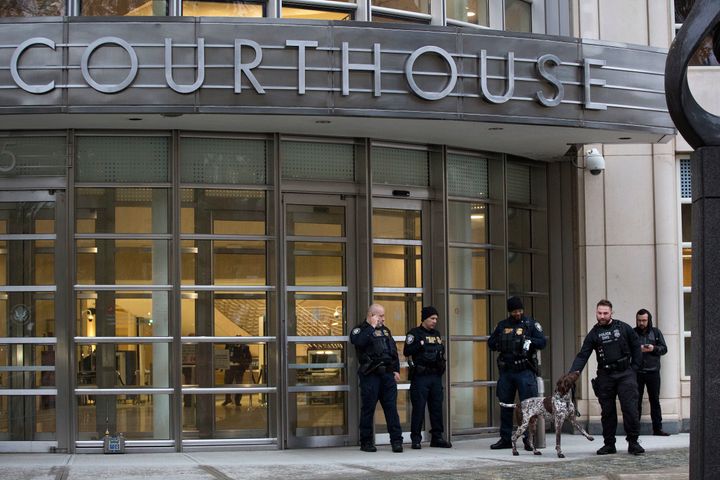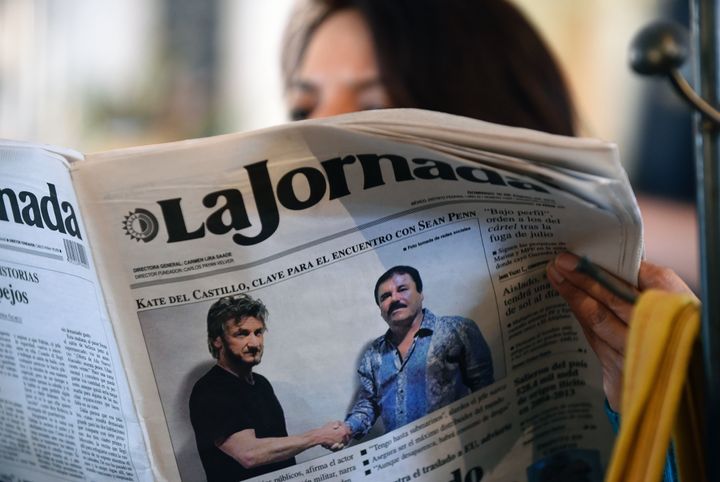Anonymous jurors with armed guards, a suspect travelling in a motorcade and erm, Sean Penn – Joaquín “El Chapo” Guzmán’s trial is clearly not just another drug trafficking case.
More than 20 years since his first encounter with police, the 61-year-old is finally standing trial in the US for allegedly masterminding the shipment of over 200,000 tonnes of drugs into the country.
But putting Mexico’s alleged “godfather of the drug world” on the stand isn’t easy, and numerous measures have been put in place to ensure the trial goes without a hitch.
Guzmán’s notoriety has already caused problems, with juror selection proving to be a minefield – so what can we expect from the next four months? And what exactly is he on trial for? Allow us to explain...
Who Is El Chapo?
The 61-year-old was long considered to be the leader of Mexico’s Sinaloa Cartel, the world’s largest drugs trafficking organisation, shipping “wholesale amounts” of marijuana, cocaine, and heroin into the US.
Born in the Mexican state of Sinaloa, Guzmán earned his height-related nickname – he’s 5ft 6ins tall and El Chapo is often translated to “shorty” – when he was a teenager, shortly before he began working in organised crime in the ’70s.
In the decades that followed, prosecutors will argue, he became “Mexico’s drugs kingpin”, overseeing multiple shipments of drugs, some as big as 19,000kg.

He’s been incredibly well-known in the US for a long time and from 2009 to 2011, Guzmán made it into Forbes’ annual ‘Most Powerful’ list, with an estimated wealth of $1bn.
At one point the US government called him “the most ruthless, dangerous, and feared man on the planet” and since 2011, the Drug Enforcement Administration (DEA) has believed his “power now surpasses the influence and reach of Pablo Escobar”.
In a previous hearing, Guzmán’s lawyers hinted that they’ll be arguing his role in the cartel is far smaller than it’s been claimed.
What Are The Charges?
Guzmán is facing a total of 17 charges for incidents that allegedly took place between 1984 and 2014. They include drugs trafficking and manufacture, money laundering, kidnap, conspiracy to murder and firearms charges.
If convicted, he’ll face life imprisonment.
What Are The Extra Security Measures?
In the run-up to the trial, Guzmán has been kept in solitary confinement at the maximum security Metropolitan Correctional Centre, with visits from his wife being prohibited.
For every hearing so far, he’s been transported to the Brooklyn courthouse in a motorcade with the busy Brooklyn Bridge being shut to other traffic while he’s on the move.
For the trial, authorities devised a top-secret plan to stop this from being a daily occurrence, later confirming he would be held in a secret location.

The 12 jurors are also being protected and will remain anonymous, with armed guards accompanying them to and from the court each day. Jury selection saw more than two dozen potential candidates dismissed, including at least two who said being part of the trial would leave them scared for their safety.
Why The High Security?
Two reasons. For a start, the rejected jurors’ fears are not trivial. The Sinaloa cartel remains a hugely powerful organisation.
To give a sense of the scale, Reuters reports that more than 200,000 people have been killed – many in cartel feuds – since the Mexican government sent troops in to take on the drug gangs in 2006.
The Sinaloa cartel operates in 17 states and has links to 50 other countries, so that’s a lot of people involved.
Over the years, Guzman has been known to use his wealth to buy off politicians, police chiefs, soldiers and judges, Mexican prosecutors have previously said, so the idea that he might come for one of the jurors is not far-fetched.
Second, he’s previously done a very good job at slipping past the authorities.
He was first arrested way back in 1993 by Guatemalan authorities, who extradited him to Mexico where he began a 20-year sentence in a maximum security prison.
But he didn’t lose any influence while behind bars, with his brother Arturo Guzmán Loera reportedly taking care of things on the outside.
In January 2001 – after years of living well in prison thanks to bribes – he escaped, with a plan that involved a laundry cart and multiple accomplices, including at least two guards.
Guzmán then managed to stay on the run for thirteen years and wasn’t recaptured until 2014, when he was found hiding in tunnels in near the Mexican city of Mazatlan.
That time around, it took him far less time to escape and he made his second unauthorised exit from a maximum security prison in 2015, by absconding through a mile-long tunnel out dug from his prison cell shower.
After recapturing him (again) in a January 2016 shootout that killed five Mexican marines, Mexico began the extradition process and US authorities have kept a tighter grip on Guzmán in the lead-up to the trial.
Anything Else?
Yes, there’s a weird twist involving actor Sean Penn. Shortly after Guzmán’s 2016 recapturing, it emerged that Penn had interviewed him while he was still in hiding.

The actor had been intending to “contribute to the conversation on the war on drugs” but on the day the Rolling Stone video was published, Guzmán was arrested.
It was then rumoured Penn’s meeting with the cartel member had led to his capture, with Mexican authorities hinting that tracking the actor’s movements led them to Guzmán.
Claiming he met the 61-year-old nowhere near where he was captured, Penn has denied this was the case, but still labelled the whole saga “a terrible regret”.
The interview itself was a bold – but perhaps not bright – move for Guzmán, as the 10,000-word piece included him appearing to admit to moving “more heroin, methamphetamine, cocaine and marijuana than anybody else in the world”.

